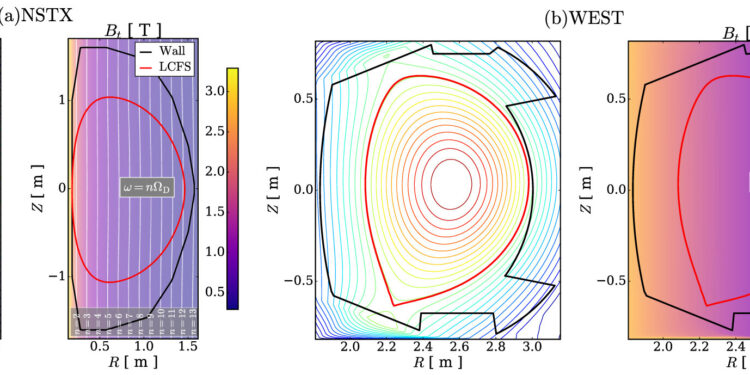Balance configurations used for (a) NSTX and (b) WEST databases, corresponding to plans 138,506 and 56,898, respectively. On the left, the magnetic equilibrium is shown with the LCFS highlighted (red) and the surface wall facing the plasma (black). On the right, the amplitude of the toroidal magnetic field Bt (colored bar) is shown, along with the relevant resonance layers (white) in (a) NSTX (i.e. harmonic resonances of deuterium, n > 1 ) and (b) WEST (i.e. fundamental resonance for hydrogen). Credit: Nuclear Fusion (2024). DOI: 10.1088/1741-4326/ad645d
New artificial intelligence (AI) models for plasma heating can do more than previously thought possible, not only increasing the prediction speed 10 million times while preserving accuracy, but also predicting properly heating the plasma in cases where the original digital code fails. The models will be presented Oct. 11 at the 66th Annual Meeting of the Plasma Physics Division of the American Physical Society in Atlanta.
“With our intelligence, we can train AI to go even beyond the limits of available numerical models,” said Álvaro Sánchez-Villar, an associate research physicist at the Princeton Plasma Physics Laboratory (PPPL). ) from the U.S. Department of Energy (DOE). Sánchez-Villar is the lead author of a new journal article in Nuclear Fusion on work. This was part of a project that spanned five research institutes.
The models use machine learning, a type of AI, to attempt to predict the behavior of electrons and ions in a plasma when ion cyclotron frequency range (ICRF) heating is applied in fusion experiments. The models are trained on data generated by computer code. Although most of the data was consistent with previous results, in some extreme scenarios the data was not as expected.
“We observed a parametric regime in which the heating profiles showed irregular peaks at rather arbitrary locations,” Sánchez-Villar said. “There was nothing physical to explain these peaks.”
Sánchez Villar identified and removed problematic data, called outliers, from the training set to train their AI because the scenarios were not physical. “We biased our model by removing peaks in the training dataset, and we were still able to predict the physics,” said Sánchez Villar.
Heating profiles for deuterium are shown in a (d) minor, (e) major, and (f) critical outliers. In black, the original digital code is displayed with aberrant features (spikes). In red, the predictions of the AI model are displayed. In green, predictions from the fixed code are shown, which were anticipated by the AI models, even predicting higher heating in the highlighted region. Credit: Álvaro Sánchez-Villar / PPPL
“As can be observed, the code correctly suppresses the spikes but anticipates higher heating in the highlighted region. However, there was no guarantee that these predictions were physical.”
Then the team went further. After months of research, the cause – a limitation of the numerical model – was identified and resolved by Sánchez Villar, who then ran the corrected version of the code for the outliers that originally showed the random spikes.
Not only did he find that the solutions were free of spikes in all problem cases, but, to his surprise, these solutions were almost identical to the solutions of one of the machine learning models predicted months before, even in critical aberrant scenarios.
“This means that, practically, our substitution implementation was equivalent to fixing the original code, simply based on careful data curation,” Sánchez-Villar said. “Like any technology, with intelligent use, AI can help us solve problems not only faster, but better than before, and overcome our own human constraints.”
As expected, the models also improved calculation times for ICRF heating. These times have been reduced from around 60 seconds to 2 microseconds, enabling faster simulations without a noticeable impact on accuracy. This improvement will help scientists and engineers explore the best ways to make fusion a practical energy source.
More information:
A. Sánchez-Villar et al, Real-time modeling of ICRF heating on NSTX and WEST via machine learning approaches, Nuclear Fusion (2024). DOI: 10.1088/1741-4326/ad645d
Provided by the Princeton Plasma Physics Laboratory
Quote: New AI models of plasma heating lead to important fixes in computer code used for fusion research (October 9, 2024) retrieved October 9, 2024 from
This document is subject to copyright. Except for fair use for private study or research purposes, no part may be reproduced without written permission. The content is provided for informational purposes only.



